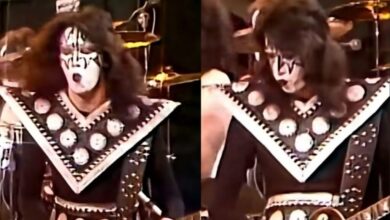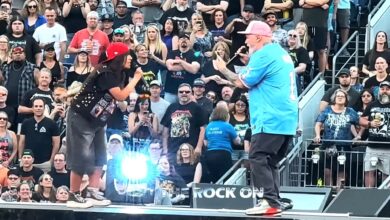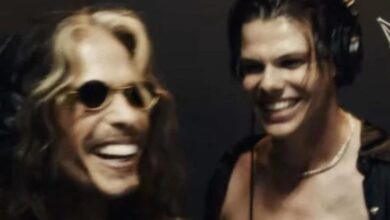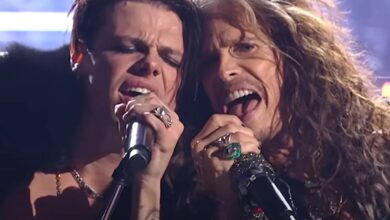Aerosmith and YUNGBLUD Tear Open a New Era of Rock with a Ferocious “Back in the Saddle” Revival
The night Aerosmith and YUNGBLUD collided around “Back in the Saddle” didn’t unfold like a typical collaboration or a nostalgia-driven guest spot. It came across as a raw shockwave between two generations who approach rebellion from completely different worlds. Aerosmith, long treated as untouchable icons even in their semi-retired chapter, stepped in with the gravity of decades behind them. YUNGBLUD showed up burning hot, reckless, and hungry — a spark just waiting to hit gasoline. When their energies met, the song didn’t just return. It mutated.
The significance of the moment was shaped by everything that led up to it. Their chemistry had already surfaced at the 2025 MTV Video Music Awards during the tribute to Ozzy Osbourne. It was a night charged with memory, emotion, and legacy. YUNGBLUD opened with raw urgency, and when Steven Tyler entered with that unmistakable rasp, the room shifted. Fans instantly recognized that the connection between them wasn’t just a one-time highlight — it was the start of something bigger than the tribute itself.
Once rumors of an official collaboration began circulating, no one was surprised. Rock has always evolved through collisions like this — younger firebrands pushing against the boundaries that older architects once shattered. Tyler publicly discussed wanting to use whatever power remained in his voice for projects fueled by meaning, not routine. YUNGBLUD, meanwhile, seemed eager for a chance to match forces with rock’s giants. Their energies didn’t clash or dilute; they amplified one another in ways neither could have achieved alone.
Selecting “Back in the Saddle” as the centerpiece of their 2025 collaboration felt intentional. The original track has always carried a swagger of pure adrenaline — a riff that charges in like an army and a chorus that lands like a punch. Since its late-’70s debut, it has stood as one of Aerosmith’s most intimidating live staples. Even casual listeners know the opening guitar line the moment it hits. It’s a sonic declaration that demands to be felt, not just heard.
When whispers of a new version surfaced, fans were divided. Some hoped for a faithful revival; others wanted a modern jolt that embraced YUNGBLUD’s combustive intensity. What emerged struck the perfect middle ground. The skeleton of the original remained untouched, but the performance erupted with a grit that felt impulsive rather than polished. Nothing about it was sanitized. Instead, it channeled the kind of messy, explosive passion that defines true rock rebirth.
Onstage, the chemistry was the engine. Steven Tyler, now singing with more gravel and fire than ever, attacked the song’s swagger with the confidence of someone who has lived every inch of it. YUNGBLUD countered with a reckless accuracy, pushing the song into a newer, sharper edge without stepping on its history. Their dueling vocal dynamics gave the performance its bite — a push-and-pull tension that elevated every moment instead of softening it.
Joe Perry’s guitar became the spine of the entire collision. That legendary riff — the one that defined arenas decades ago — returned with the same ferocity, unsoftened by time. Perry played like he refused to acknowledge age at all, smacking the strings with the authority of someone who built his sound from blood and voltage. YUNGBLUD didn’t simply sing over it; he chased the riff, clung to it, and let it drag him deeper into the performance’s chaos. That friction gave the collaboration its life.
Beneath all the volume was a current of emotion. Aerosmith’s appearances have become rarer, and fans are acutely aware of the physical hurdles and aging realities shaping the band’s present. So when Tyler steps onstage for something like this, it feels significant — not routine. “Back in the Saddle” turned into more than a song title. It became a declaration: the fire still burns, even if the flames appear less often. Tyler’s delivery carried a weight and vulnerability that wasn’t present decades ago, adding a new dimension to the classic.
For YUNGBLUD, the experience carried its own meaning. He approached Aerosmith not as untouchable monuments but as creative equals ready to cause trouble together. That mindset kept the performance sharp rather than sentimental. Instead of turning the moment into a quiet homage, he injected volatility — the kind that makes rock feel dangerous again. His energy didn’t overshadow Aerosmith; it lit a fuse under them.
The reaction from fans was immediate and passionate. Social media lit up with praise from both sides of the generational divide. Aerosmith devotees applauded Tyler’s staying power and Perry’s still-monstrous riffing. Younger audiences celebrated YUNGBLUD’s refusal to treat the collaboration as sacred ground. Even skeptics of cross-generational pairings found themselves impressed by how naturally the two artists fused their identities without compromising the core of the song.
The 2025 recording stood out because it rejected any attempt to clean things up. It wasn’t engineered into a glossy, radio-friendly hybrid. It kept the imperfections — the breath, the crackle, the grit — that made the original unforgettable. Aerosmith’s legacy was built on unpolished honesty, while YUNGBLUD’s strength lies in chaos. Together, they created something that felt more like a revival than a remake. The claws stayed sharp.
Zooming out, the collaboration highlighted something broader about the state of rock music today. Genres evolve, merge, and fracture, but moments like this show that rock’s heart still beats — not as nostalgia, but as a force passed like a torch. Aerosmith brought history; YUNGBLUD brought youth; both brought attitude. It confirmed that rock’s signature defiance isn’t tied to age, era, or polish. It’s tied to spirit.
“Back in the Saddle” endures because its structure is timeless. The galloping groove, the larger-than-life chorus, the adrenaline-fueled progression — none of it loses power with time. The 2025 version proved its architecture is still bulletproof. New voices can attack it without dimming the identity that made it legendary.
The collaboration’s roots in an Ozzy Osbourne tribute added poetic symmetry. Ozzy himself symbolized unity across generations and subgenres. Watching Aerosmith and YUNGBLUD first connect under that umbrella — then transform that spark into a full collaboration — extended the lineage of artists bridging eras. It hinted at a future where legacy and youth don’t collide; they coexist.
By the time the performance carved its mark into fan memory, the collaboration had grown beyond a simple remake or symbolic partnership. It became a rallying cry. For Aerosmith, it showed the band’s pulse remains loud even in rare appearances. For YUNGBLUD, it was another charge in his mission to yank rock back into relevance. For listeners, it was a reminder that some songs don’t just return — they erupt.
Whether or not they ever unite again, this moment already stands as a beacon. If future performances emerge, they’ll likely appear just as this one did — unexpectedly, unapologetically, and completely on their own terms. What’s certain is that “Back in the Saddle” gained a new chapter in 2025, proving that as long as someone’s bold enough to grab the reins, rock’s wild ride is never over.





